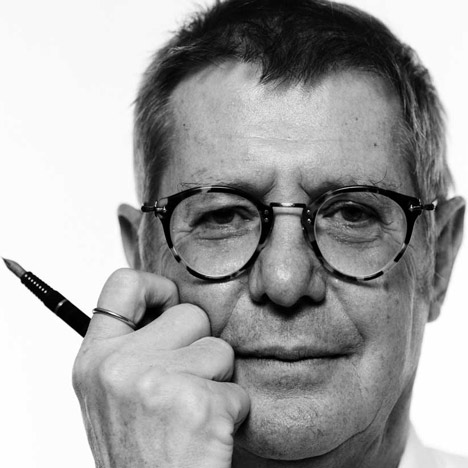
Venice Architecture Biennale "cannot get any worse" says Wolf D Prix
Dezeen Wire: architect Wolf D Prix of Coop Himmelb(l)au has launched a scathing attack on the Venice Architecture Biennale, claiming it's "no longer about lively discussion and criticism of topics in contemporary architecture" but places too much importance on celebrity.
In a statement sent as a press release entitled The Banal, he says that participating architects are "playing" while the profession is "sinking into powerlessness and irrelevance" at the hands of politicians, investors and bureaucrats who "have been deciding on our built environment for a long time now".
Prix would have preferred a "look behind the scenes at the decision-making, instead of boring exhibitions", giving controversial plans to redevelop Stuttgart train station, the spiralling cost of Herzog & de Meuron's Elbphilharmonie concert hall and political disputes about mosques and minarets as examples of good topics.
He also criticises biennale director David Chipperfield for encouraging cooperation with the authorities rather than resistance, calling his theme of Common Ground a "compromise" that "cannot get any worse".
Assistant director of the biennale Kieran Long responded by tweeting "I think if Wolf Prix hates you, you are doing something right," while Charles Holland of London architects FAT, who created a Museum of Copying for the Aersenale exhibition, tweeted "Wolf Prix say hello to black kettle. Kettle, say hi to famous pot Wolf Prix."
In his opening speech at the press conference on Monday Chipperfield claimed “this biennale isn’t an X Factor of who’s hot right now”, a sentiment also expressed in our movie interview in which he urges the profession to turn away from iconic one-off projects like opera houses, theatres and museums, and address “the 99.99% of the rest of the world which architects are not dealing with” before they're relegated to being “urban decorators.”
See all our stories about the Venice Architecture Biennale »
See all our stories about Coop Himmelb(l)au »
Portrait is by Elfie Semotan.
Here's the full statement from Wolf D Prix:
The Banal
Praise be to Nero’s Neptune.
The Titanic sails at dawn.
And everybody’s shouting
“Which Side Are You on?”
(Bob Dylan: “Desolation Row”, 1966)
If one did not know that the media constantly exaggerates, one could almost conclude – as the Süddeutsche Zeitung has – that the Venice Biennale of Architecture really is the world’s most important architecture exhibition.
However, I believe that the word “exhibition” is not intended to describe an exhibition in this case, rather that the notion only designates the event per se. In other words an industry meeting, like a product fair. Other critics fail to even question the purpose of the exhibition, rather they immediately conclude that the coming together, the meeting, the networking is the key aspect. That’s that!
I would like to maintain at this juncture that the meaning of the Venice Biennale of Architecture for theoretical arguments has been increasingly losing significance since its beginnings with the Strada Novissima by Paolo Portoghesi in 1980. Even the personal significance for the participants is very low when compared to the Art Biennale. So let us not deny the truth. This event is an expensive danse macabre. In a city of plunder (an exhibition of plunder) hordes of tourists (architects) roll along broken infrastructure in order to satisfy their petit bourgeois desire for education (in the case of the architects: vanity, envy, schadenfreude, suspicions). Even the glamour that the visitors are supposed to feel is staid and faked by the media for whom a star architect is like a film star.
In truth it is all hollow, arduous, exhausting, bleak and boring. It is no longer about lively discussion and criticism of topics in contemporary architecture, but rather about empty, conservative and perhaps populist shells that are charged with feigned meaning. What a great Architecture Biennale it would have been had they established forums and put out themes which would have provided a chance to look behind the scenes at the decision-making, instead of boring exhibitions. Take for example the dispute about the train station in Stuttgart. The reasons for the cost explosion for prominent buildings such as, for example, the Elbe Philharmonic Hall. The political arguments about mosques and minarets, in other words the disputes about the localisation of an idea. Why the market for single-family homes in the USA has collapsed and how power politics is conducted through settlement architecture. These topics would be worthy of discussion – not who is and who is not a star architect.
However, instead of that we face: “People Meet in Architecture” and now “Common Ground”. In other words: compromise. It cannot get any worse!
This situation conjures an image of the Venetian carnival – one can imagine all the architects in Pierrot costumes surrounded by masked critics and dancing the Dance Banale, or, even better, the architects are playing on a sinking gondola like erstwhile the orchestra on the Titanic playing their last song, while outside in the real world our leaky trade is sinking into powerlessness and irrelevance. This is because politicians and project managers, investors and bureaucrats have been deciding on our built environment for a long time now. Not the architects.
While in Russia artists are stubbornly resisting the authoritarian regime, the current director of the Architecture Biennale considers these characteristics to be obstacles for our profession and he explains in an interview that space must be taken from the genius. One would have to show him Pussy Riots in order for him to finally understand our society.
Furthermore, I consider that the Venice Biennale of Architecture needs to be reorganised.
Wolf D. Prix / COOP HIMMELB(L)AU